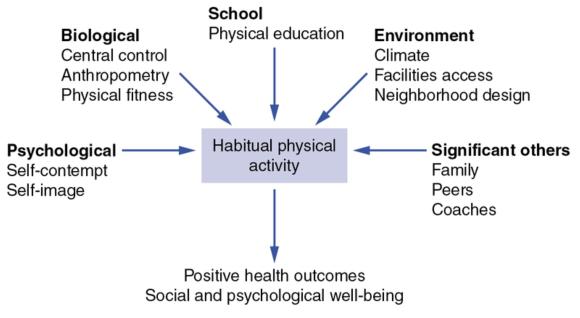Physical activity levels: Familial and twin studies
This is an excerpt from Biologic Regulation of Physical Activity by Thomas W Rowland.
The premise to be weighed in the pages that follow is this: There exists within the central nervous system an inherent control center that serves to regulate an individual's daily energy expenditure by motor activity. According to this concept, such an activity governor within the brain is involuntary and acts to influence levels of activity beneath the level of consciousness, differentiating it from motor centers within the cerebral cortex responsible for purposeful muscular activity. This governor is a shared function throughout the animal kingdom. It may act as a means of maintaining the body's energy balance, and its existence is consistent with other feedback regulatory centers in the brain critical to maintaining homeostasis, including controllers of temperature, pH, body fluid content, and blood glucose levels.
The credibility of this concept is strengthened by a considerable body of observational and interventional data from diverse sources in both human and animal models supporting the existence of such an involuntary biologic influence on activity energy expenditure. And, in providing a scientific foundation for such a brain function, that information raises significant questions regarding the quantitative importance and plasticity of a biologic controller in response to extrinsic manipulation.
The role of a deterministic biological control of habitual physical activity needs to be considered in the context of a real-world universal model explaining human motor activity. As depicted schematically in figure I.1, daily physical activity, as with most human behaviors, reflects the causal inputs of a variety of physical, psychological, social, and environmental factors. The central argument in the pages that follow holds that (a) such central control exists and (b) its potential influence on activity behaviors should not be ignored.

Figure I.1 The basic schema by which multiple determinants might act to dictate physical behavior for health outcomes in humans.
One of the most compelling pieces of evidence for the existence of biological control of physical activity comes from the observation that levels of daily energy expenditure through physical activity in both humans and animals (adjusted for body size) steadily decline during the course of a lifetime. This fall in daily activity with increasing age is observed in virtually all animal species and is consistent regardless of measurement technique.
As further supporting evidence, experimentally induced lesions in particular parts of the brain in animals can produce reduced or increased levels of physical activity. Changes in physical activity have been observed in human beings with certain brain tumors (i.e., craniopharyngioma). And disease states characterized by increased motor activity (anorexia nervosa, restless legs syndrome, attention deficit hyperactivity disorder) are considered to reflect catecholamine imbalance in the central nervous system. Biochemical effects on the brain that alter habitual activity levels have been described for a variety of administered drugs and chemical agents in both humans and animals. Similarly, certain deficiency and toxic states have been associated with changes in physical activity habits.
If a biologic controller of physical activity exists, activity levels should be expected to demonstrate some evidence of a genetic effect. In fact, from twin and family studies, heritability levels of daily physical activity have been reported to range from 30% to 60%. Recent advances in molecular genetics have permitted identification of specific gene loci that are associated with activity energy expenditure. The observation that spontaneous physical activity demonstrates a temporal rhythmicity expected of biological systems provides further evidence for such an intrinsic central brain controller.
The demonstration that physical activity levels are linked to a level of biological (sexual) development in youth supports a biological influence on regular motor activity. That boys are consistently found to be engaged in greater levels of habitual activity than girls during the pediatric years has traditionally been explained by sociocultural influences. However, such sex differences in motor activity have been documented in very early infancy when the effects of such influences are expected to be minimal, suggesting some biological basis.
Learn more about Biologic Regulation of Physical Activity.
More Excerpts From Biologic Regulation of Physical ActivitySHOP

Get the latest insights with regular newsletters, plus periodic product information and special insider offers.
JOIN NOW


